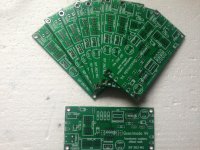Hi Fab, yes PM mailing adressHi Hicoco
Do you have one spare pcb for me?
Thanks
Fab
I just built up a through hole version and it worked perfectly and is so easy to use! I will be busy snubbing some diy gear in the near future. Thanks Mark!
If anybody in North America wants a V4 through hole board I have an extra one and will ship it to you no charge. First to PM me wins the prize!
If anybody in North America wants a V4 through hole board I have an extra one and will ship it to you no charge. First to PM me wins the prize!
Hi, thanks for the compliment ...
This is my little snubber module that I inserted in my BOZ Nelson Pass preamp. Can this solution work, are there any contraindications?
Bye…
Looks good to me....
this is my result for AMGIS L01-6364, 2x115V / 2x18v / 25VA, and i am confused because Cs is 3 time Cx
CX: 0,22uF
CS: 0,68uF
RS: 11 Ohm
fosc ~ 60kHz
I have a very hard time to check and use the Math for verification, by any chance someone have an Excel were we can enter the values we found ( Cx, Cs, Fosc) with the result of RS....for Zeta=1
CX: 0,22uF
CS: 0,68uF
RS: 11 Ohm
fosc ~ 60kHz
I have a very hard time to check and use the Math for verification, by any chance someone have an Excel were we can enter the values we found ( Cx, Cs, Fosc) with the result of RS....for Zeta=1
Yes please PM mailing address...Hi Hicoco, I'd like to have one of your boards if there're any left. Merci.
this is my result for AMGIS L01-6364, 2x115V / 2x18v / 25VA, and i am confused because Cs is 3 time Cx
CX: 0,22uF
CS: 0,68uF
RS: 11 Ohm
fosc ~ 60kHz
I personally would never use a 2C+1R transformer secondary snubber whose (Cs/Cx) ratio was that low. Never!
The article I wrote for Linear Audio contained an Appendix with lots of mathematics, including a derivation and calculation of the minimum acceptable ratio (Cs/Cx). After quite a lot of algebra, the answer was: (Cs/Cx) >= 15 keeps you out of trouble when operating at critical damping, zeta=1. You may recall that 15 was the ratio suggested "as a starting point" in the Quasimodo Design Note .pdf. Increasing the (Cs/Cx) ratio is even better, if you can afford to buy even larger values of Cs capacitance.
Post #17 of the Quasimodo Results (ONLY) thread shows a 2C+1R snubber with a (Cs/Cx) ratio of one hundred forty three (!). It keeps you out of trouble over a nice wide range of zeta values.
I recommend that you discard any results obtained with (Cx=0.22uF and Cs=0.68uF). Also discard whichever messages or websites or circuit designers who suggested these values. I recommend that you choose a (Cs/Cx) ratio greater than 15, obtain new capacitors in this ratio, and run your Quasimodo tests again.
However, this is a DIY hobby and obviously you have the freedom to do whatever you like. You have the freedom to discard the recommendations in this message. You can plug in whatever capacitor values suit your fancy and nobody can stop you.
Thanks Marc, i will do a new testsI recommend that you discard any results obtained with (Cx=0.22uF and Cs=0.68uF). Also discard whichever messages or websites or circuit designers who suggested these values. I recommend that you choose a (Cs/Cx) ratio greater than 15, obtain new capacitors in this ratio, and run your Quasimodo tests again.
However, this is a DIY hobby and obviously you have the freedom to do whatever you like. You have the freedom to discard the recommendations in this message. You can plug in whatever capacitor values suit your fancy and nobody can stop you.
Fortunately, the cathedral has survived and will be rebuilt🙂Yeah, no ringing for a while.
"Mindful" builders will make an attempt to think for themselves.
"Mindless" builders will make an attempt to read what mindful builders have written. Including what is written on pages 6 thru 8 of the Quasimodo Design Note, attached to post #1 of this thread.
"Mindless" builders will make an attempt to read what mindful builders have written. Including what is written on pages 6 thru 8 of the Quasimodo Design Note, attached to post #1 of this thread.
- Home
- Amplifiers
- Power Supplies
- Simple, no-math transformer snubber using Quasimodo test-jig

